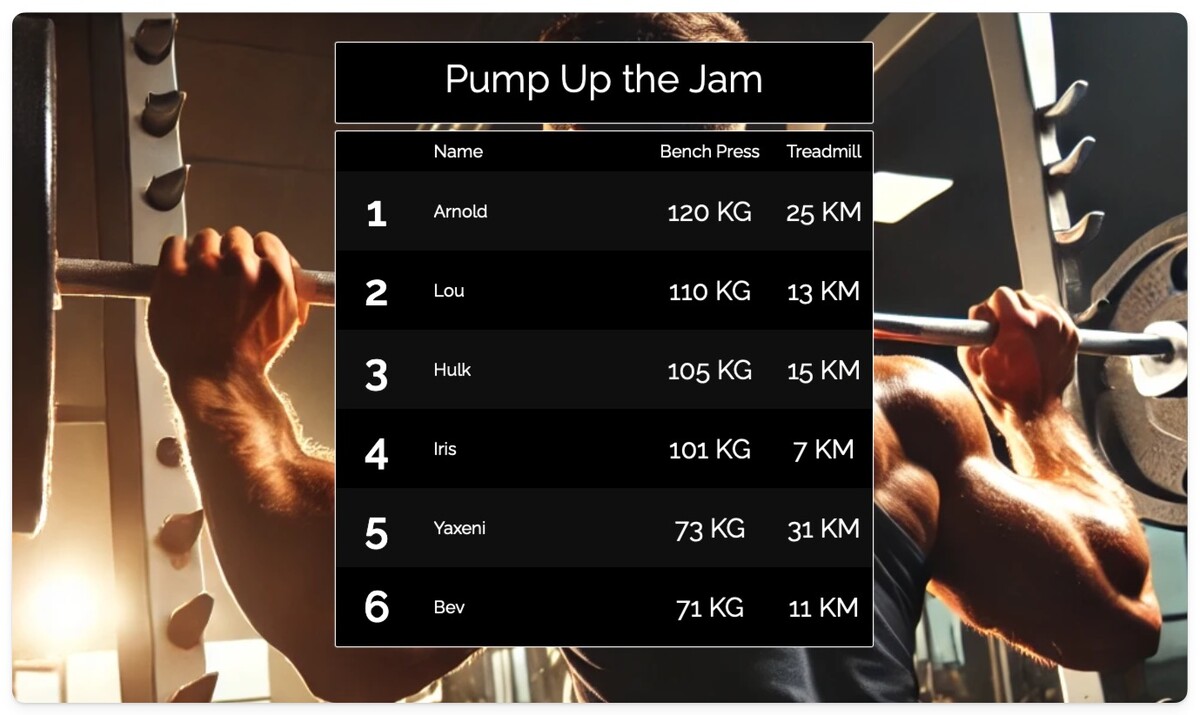Remember when fitness meant lonely gym sessions, boring treadmill runs, and constantly falling off the wagon? That was before Sarah’s office started their “Steps Around the World” challenge. In 90 days, her team virtually walked from New York to Tokyo, lost a collective 180 pounds, and something unexpected happened—they actually had fun doing it.
Sarah’s story isn’t unique. Across gyms, offices, and online communities worldwide, fitness leaderboards are transforming exercise from a dreaded chore into an engaging adventure. The secret? They tap into our fundamental human drives for competition, community, and visible progress.

The Science: Why Fitness Leaderboards Work
The Motivation Multiplier Effect
Here’s what every failed New Year’s resolution teaches us: willpower is a terrible fitness strategy. It’s finite, depletable, and usually exhausted by February. Traditional fitness approaches demand we fight our nature—forcing ourselves to do something unpleasant for a distant, abstract reward. No wonder 80% of people quit their fitness routines within six weeks. Fitness leaderboards flip this equation entirely, aligning multiple psychological drivers that pull us forward rather than requiring us to push ourselves.
Consider social accountability, the invisible force that makes us show up when we’d rather stay in bed. When your name sits at #47 on a public leaderboard, that 6 AM workout isn’t just about you anymore. Your absence is visible. Your decline is documented. Your comeback is celebrated. Research from Dominican University shows that people who share their goals publicly achieve them 65% of the time. Add a competitive leaderboard where others can see your daily progress, and success rates jump to 95%. It’s not about shame—it’s about belonging. Letting down the leaderboard feels like letting down your team.
Our brains evolved to track relative position in social hierarchies—it was survival. “Am I safe? Am I valued? Am I progressing?” These questions run constantly in our subconscious. Leaderboards answer them instantly. That climb from 50th to 35th place floods your brain with dopamine, the same neurotransmitter triggered by cocaine, sex, and chocolate. But unlike those fleeting pleasures, fitness leaderboards create sustainable motivation loops. Each workout improves your ranking, which releases dopamine, which motivates the next workout. You’re not fighting your brain chemistry; you’re surfing it.
Perhaps most powerfully, leaderboards transform isolation into connection. Running alone at dawn is lonely. Running alone at dawn while 200 other people worldwide are doing the same challenge, watching your progress, cheering your PRs? That’s community. That’s belonging. That’s why you’ll set your alarm tomorrow.
The Numbers Don’t Lie
Studies on fitness gamification reveal impressive results:
- 48% increase in exercise frequency when leaderboards are implemented
- 3x longer sustained engagement compared to solo fitness tracking
- 71% of participants report exercising harder with leaderboard competition
- 89% completion rates for challenges with leaderboards vs. 23% without
Dr. Michelle Segar, behavioral scientist at University of Michigan, explains: “Leaderboards transform exercise from a ‘should’ into a ‘want to.’ When fitness becomes social and competitive, it activates the same reward centers as playing games—making it inherently more enjoyable.” The science behind why leaderboards work so effectively reveals how competition triggers dopamine and motivation centers in our brains.
Types of Fitness Challenges That Thrive with Leaderboards
Step Challenges: The Gateway Drug of Fitness
Step challenges are the most accessible entry point to fitness gamification:
Why They Work:
- Low barrier to entry (everyone walks)
- Easy tracking via smartphones
- Scalable to any fitness level
- Visible throughout the day
Popular Variations:
- Virtual Journeys: “Walk to Mordor” (1,779 miles from Hobbiton)
- Landmark Challenges: Steps to climb Empire State Building (1,576 steps)
- Team Relays: Combined steps to reach destinations
- Daily Battles: Highest step count wins the day
Success Story: Microsoft’s global step challenge involved 70,000 employees across 70 countries. Participants averaged 11,000 steps daily (up from 6,000), with 73% maintaining increased activity levels six months later. This demonstrates how corporate gamification strategies can extend beyond productivity to employee wellness.
Running Challenges: Building Endurance Together
Running leaderboards transform solitary miles into social achievements:
Tracking Options:
- Total monthly mileage
- Fastest 5K/10K times
- Consistency streaks (days run)
- Elevation gained
- Virtual races completed
Community Building Features:
- Route sharing and recommendations
- Pace group formations
- Virtual running buddies
- Race training partnerships
Case Study: Nike Run Club’s leaderboard system has 10+ million active users. Members who participate in challenges run 35% more miles and are 3x more likely to complete their first race.

Strength Training: Beyond the Mirror
Strength leaderboards shift focus from appearance to performance:
Measurable Metrics:
- Total weight lifted per session
- Personal record improvements
- Workout completion streaks
- Exercise variety scores
- Form video challenges
Creative Challenges:
- Plank Wars: Cumulative plank hold time
- Push-up Pyramid: Daily increasing reps
- Dead Hang Challenge: Grip strength endurance
- Squat September: 30-day progressive overload
Transformation Story: CrossFit’s annual Open competition uses worldwide leaderboards. In 2023, 300,000+ participants completed workouts they never thought possible, with 67% reporting significant strength gains.
Weight Loss Challenges: Healthy Competition
Weight loss leaderboards require careful design to promote healthy habits:
Best Practices:
- Focus on percentage lost, not absolute pounds
- Include non-scale victories (measurements, photos, energy levels)
- Reward consistency over rapid loss
- Celebrate diverse body types and goals
Multiple Metrics Approach:
- Weight change percentage
- Workout frequency
- Nutrition logging consistency
- Water intake tracking
- Sleep quality scores
Warning: Always emphasize safe, sustainable loss (1-2 pounds weekly) and require medical clearance for participants with health conditions.
Real-World Success Stories
Corporate Wellness Revolution: Google’s Fitness Gamification
The turning point came during Google’s 2019 health insurance review. Despite offering premium gym memberships, on-site fitness centers, and unlimited healthy food, only 12% of employees regularly exercised. Healthcare costs were rising, productivity dipped after lunch, and the famously energetic Google culture was becoming sedentary. The wellness team’s solution wasn’t more perks—it was gamification.
“gFit Challenge” launched with the fanfare of a product release. Engineers who optimized algorithms now optimized their step counts. Product managers who tracked user metrics tracked their heart rates. Sales teams who competed for contracts competed for cycling miles. The quarterly competitions between offices became legendary—Mountain View versus London, Tokyo versus New York. Points accumulated for everything: steps taken, weights lifted, yoga sessions completed, even meditation minutes. But the genius was the integration—your Fitbit, Apple Watch, Strava, whatever you used, fed directly into the leaderboard displayed on screens throughout every office.
The transformation was immediate and profound. Participation exploded from 12% to 78%. Lunchtime became workout time. Engineers held walking meetings. The Bangalore office installed treadmill desks after losing to Singapore. Sick days dropped 31%, saving $3.2 million annually in healthcare costs. But the real victory was cultural—94% of employees reported the program made Google a better place to work. The “Fitness Levels” system, where employees progressed from “Rookie” to “Legend,” became as coveted as promotion levels. Legends earned premium gym access, personal training sessions, even extra vacation days. “We didn’t just get healthier,” one engineer noted. “We remembered why we loved working here—everything is a game worth winning.”
Community Transformation: Small Town, Big Results
Worthington, Minnesota was dying—not dramatically, but slowly, pound by pound. The town of 13,000 had three McDonald’s but no gym. The high school football team hadn’t won in five years. Diabetes rates exceeded state averages by 40%. Then Mayor Sarah Johnson saw something that changed everything: her teenage son and his friends spent six hours trying to beat each other’s scores in a fitness app. “If kids will exercise for six hours to top a leaderboard,” she thought, “why can’t we do this town-wide?”
“Worthington Moves” started with a simple wooden leaderboard in the town square, updated weekly by hand. Families competed against families. The fire department challenged the police department. Third-graders battled fourth-graders. Local businesses sponsored monthly themes—Casey’s General Store backed “Walking February,” the bank promoted “Cycling Summer,” the church organized “Strength September.” The hardware store owner started opening at 5 AM so early morning walkers could log their steps. The diner created a “Leaderboard Leaders” healthy menu. High school students earned community service credits for leading senior citizen walking groups.
One year later, Worthington was transformed. Forty-three percent of residents had participated—nearly 6,000 people actively competing. The average BMI dropped 1.2 points, hospital admissions for obesity-related conditions fell 18%, and the town spawned three new fitness businesses including a CrossFit box in an old grain silo. But the statistics don’t capture the real change. “The leaderboard became our social network,” Mayor Johnson explains. “Instead of talking about the weather, we talked about our step counts. Instead of gossiping, we encouraged each other’s progress. Fitness didn’t just become part of our town—it became our town’s identity. We went from the diabetes capital of Minnesota to the fitness capital. All because of a piece of wood in the town square that showed who walked the most.”
![]()
Virtual Fitness Community: Peloton’s Leaderboard Magic
When John Foley pitched Peloton to investors, they laughed. “You want people to pay $2,000 for a stationary bike to ride alone in their house?” But Foley knew something they didn’t—people weren’t buying a bike; they were buying belonging. The leaderboard wasn’t a feature; it was the product.
Every Peloton ride becomes a race, even at 5 AM in your garage. As you pedal, your ranking updates in real-time—passing “SpinDaddy42,” getting passed by “QuadGoddess.” You high-five strangers who become friends. You follow people whose output inspires you. You filter the leaderboard by age, gender, or hashtag tribes (#PelotonMoms, #PowerZonePack). Your personal records are celebrated by thousands. Your 100th ride gets a shoutout from the instructor. You’re never alone because 500 other people are suffering through the same climb, chasing the same numbers, fighting for the same glory.
The psychology is addictive by design. Members with leaderboard friends work out five times more than solo riders. Ninety-two percent report pushing harder because of the rankings—not to win, but to not embarrass themselves. Users average 24 workouts monthly, with 95% retention after a year. One user captures the magic: “I’m a 45-year-old accountant in Ohio, but for 45 minutes, I’m competing against a DJ in Denmark, a surgeon in Singapore, a stay-at-home mom in Maine. We’ve never met, but we ride together every morning. The leaderboard makes us a team.” Peloton didn’t create a fitness platform; they created a competition platform that happens to involve exercise. Four billion dollars later, the investors aren’t laughing anymore.
Building Your Own Fitness Leaderboard Challenge
Phase 1: Foundation (Week 1)
Define Your Challenge:
- Choose primary metric (steps, miles, workouts, etc.)
- Set duration (30-day sprints work best initially)
- Determine participation requirements
- Establish safety guidelines
Set Clear Rules:
- How points are earned
- What activities count
- Evidence requirements (honor system vs. verification)
- Disqualification criteria
Phase 2: Community Building (Week 2)
Recruit Participants:
- Start with enthusiastic early adopters
- Create compelling challenge narrative
- Emphasize fun over fitness level
- Offer multiple difficulty tiers
Foster Engagement:
- Create communication channels (Slack, WhatsApp, Facebook)
- Appoint team captains or ambassadors
- Share inspiring success stories
- Post daily motivation and tips
Phase 3: Launch and Sustain (Weeks 3-4+)
Kickoff Strong:
- Host launch event (virtual or in-person)
- Explain tracking and reporting
- Demonstrate leaderboard updates
- Celebrate early achievements
Maintain Momentum:
- Weekly mini-challenges within main challenge
- Spotlight different participants
- Share progress photos and stories
- Address concerns quickly
Technology and Tools
All-in-One Fitness Platforms:
- Strava: Running/cycling with segments and KOMs
- MyFitnessPal: Nutrition and exercise tracking
- Fitbit Challenges: Step and activity competitions
Simple Leaderboard Solutions:
- Leaderboarded: Visual leaderboards perfect for gym displays
- Google Sheets: Free, collaborative tracking
- ChallengeRunner: Specialized fitness challenge platform
Wearable Integration:
- Apple Watch competitions
- Garmin Connect challenges
- Fitbit group challenges
- Whoop team tracking
Design Principles for Successful Fitness Leaderboards
Inclusivity First
Multiple Categories Ensure Everyone Can Win:
- Absolute performance (highest steps, fastest times)
- Improvement percentage (personal progress)
- Consistency awards (streak tracking)
- Spirit prizes (encouragement, positivity)
Adaptive Challenges:
- Wheelchair-accessible alternatives
- Low-impact options for injuries
- Age-bracketed competitions
- Beginner-friendly tiers
Balancing Competition with Wellbeing
Prevent Burnout:
- Mandatory rest days in challenges
- Cap daily maximum points
- Reward recovery activities (yoga, stretching)
- Monitor for overtraining signs
Mental Health Considerations:
- Optional anonymity settings
- Focus on effort over outcomes
- Celebrate all body types
- Professional support resources available

Sustaining Long-term Engagement
Seasonal Variations:
- New Year: “Resolution Revolution”
- Spring: “Summer Body Prep”
- Summer: “Outdoor Adventure Series”
- Fall: “Holiday Hustle Prevention”
Progressive Difficulty:
- Start with achievable goals
- Gradually increase challenge intensity
- Introduce new metrics and activities
- Level up system for veterans
Common Pitfalls and How to Avoid Them
Pitfall 1: The Intimidation Factor
Problem: Beginners see elite athletes dominating and give up
Solution:
- Separate leagues by fitness level
- Highlight improvement over absolute performance
- Feature “Biggest Improver” prominently
- Create beginner-only challenges
Pitfall 2: The Honesty Problem
Problem: People inflate numbers or cheat
Solution:
- Require photo/screenshot verification for milestones
- Use app integration for automatic tracking
- Implement peer verification systems
- Focus on community over prizes
Pitfall 3: The Dropout Dilemma
Problem: Initial enthusiasm fades after week one
Solution:
- Shorter challenge durations (2-4 weeks)
- Mid-challenge reset opportunities
- Team accountability partnerships
- Regular new participant onboarding
Pitfall 4: The Injury Risk
Problem: Overenthusiastic participants hurt themselves
Solution:
- Mandatory safety briefing
- Daily point/activity caps
- Rest day requirements
- Professional guidance available
The Psychology of Sustainable Fitness Motivation
Moving Beyond Extrinsic Rewards
While leaderboards provide powerful external motivation, sustainable fitness requires internal drive:
The Transition Strategy:
- Start with heavy gamification and rewards
- Gradually emphasize personal achievements
- Celebrate intrinsic benefits (energy, mood, health)
- Create identity shift from “challenge participant” to “active person”
Building Fitness Identity
Leaderboards work best when they help people see themselves differently:
Identity Formation Process:
- Public commitment creates consistency pressure
- Small wins build self-efficacy
- Community provides new reference group
- Achievements become part of personal narrative
Research shows that people who identify as “athletes” or “fitness enthusiasts” exercise 5x more than those who say they “try to work out.”
Measuring Success Beyond the Leaderboard
Quantitative Metrics
Participation Data:
- Sign-up rates
- Active participation percentage
- Completion rates
- Retention for multiple challenges
Health Outcomes:
- Aggregate weight loss
- Fitness test improvements
- Reduced sick days
- Healthcare cost changes
Qualitative Indicators
Community Health:
- Participant testimonials
- Social connection scores
- Mental health improvements
- Culture shift observations
Behavioral Changes:
- Continued activity post-challenge
- Healthy habit adoption
- Peer influence spread
- Leadership emergence
The Future of Fitness Leaderboards
AI-Powered Personalization
Next-generation fitness leaderboards will use artificial intelligence to:
- Adjust difficulty based on individual progress
- Predict and prevent injury risks
- Match compatible workout partners
- Create personalized challenges
Virtual Reality Integration
VR fitness is exploding, with leaderboards enabling:
- Global competitions in virtual environments
- Avatar-based anonymity options
- Gamified workouts in fantasy settings
- Real-time coaching and form correction
Blockchain and NFTs
Emerging technologies may enable:
- Portable fitness achievements across platforms
- Verified personal records
- Cryptocurrency rewards for achievements
- Decentralized fitness communities

Your 30-Day Quick Start Guide
Week 1: Planning
- Define your fitness goal and metrics
- Choose your tracking method
- Recruit 5-10 participants
- Set up your leaderboard
Week 2: Launch
- Host kickoff meeting/call
- Explain rules and tracking
- Create communication channel
- Complete first weekly update
Week 3: Engage
- Introduce mini-challenge
- Spotlight participant stories
- Address any issues
- Celebrate milestones
Week 4: Sustain
- Gather feedback
- Plan next challenge
- Recognize achievements
- Document lessons learned
Conclusion: The Fitness Revolution Is Social
Fitness leaderboards aren’t just about competition—they’re about connection. They transform the lonely pursuit of health into a shared adventure, making fitness fun, social, and sustainable.
The magic happens when someone who’s never enjoyed exercise suddenly finds themselves checking the leaderboard before breakfast, planning walking meetings to boost their step count, or texting their team about completing a workout. That’s when fitness stops being a chore and becomes part of who they are.
Whether you’re a gym owner looking to boost member engagement, an HR manager designing wellness programs, or just someone tired of failed fitness resolutions, leaderboards offer a proven path to lasting change. They work because they align with human nature—our desires to compete, connect, and continuously improve.
The question isn’t whether fitness leaderboards work—the evidence is overwhelming. The question is: what’s stopping you from starting your own fitness challenge today?
Ready to launch your own fitness challenge? Create a motivating fitness leaderboard in minutes with Leaderboarded. Free to start, easy to share, and guaranteed to get your community moving. Your fitness revolution starts with a single click.